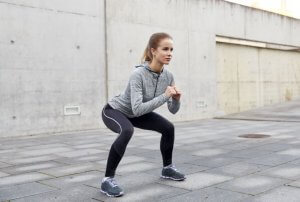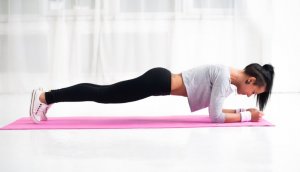Five Effective Exercises to Burn Calories

Establishing an exercise routine to burn calories is relatively easy. However, to be successful and enjoy the results, several elements must be brought together. A perfectly balanced diet is one of them, in addition to consistency and discipline to comply with the workouts.
What are calories?
There are people who start exercise routines to burn calories, without fully understanding what calories are and what their function is within the body.
In simple terms, calories refer to the amount of energy required by your body to perform its basic functions. From the proper functioning of your heart and your entire circulatory system to muscle strength, as well as reproduction and regeneration of the body’s tissues.
The body extracts calories from the oxidation of carbohydrates, fats and proteins. Alcohol is another source of calories, but these calories are considered to be “empty” calories, meaning they don’t provide any nutrients.
The elimination of nutritious elements is a frequent mistake made by some people who want to lose weight quickly. In the case of a deficit, the body will extract calories from body tissues, generating an imbalance. This is as potentially dangerous as being overweight.
Exercises to burn calories
The first step with any workout is a warm-up, a period designed to raise the temperature of your muscles and prepare them for action. Walking at a moderate pace for 10 minutes before exercise is a good example of a warm-up.
Next, you can do 15 simple squats and swing your legs and arms for a couple of minutes. You should include stretching your neck, wrists, knees, and ankles. Jumping rope is another calisthenics exercise that, as an added value, is effective for starting to burn calories.
Jumping squats

In addition to being very efficient at burning calories and fat, squats and all their variants are part of most routines for toning the lumboabdominal area, buttocks, thighs, and calves.
The correct position to begin this routine is with your legs shoulder-width apart and your fingers pointing slightly outwards.
For a correct execution, you must bend your knees, keeping your back completely straight, as if you were sitting in an imaginary chair. When you’re lowering your body, put your arms towards the front, in a parallel line with the floor.
Next, jump by raising your arms above your head, land as softly as possible and complete the exercise by “sitting” on the imaginary chair. You should do 12 repetitions in a maximum time of 30 seconds.
Hand raising push-ups
This is the traditional movement of bending and stretching your elbows from the plank position. But, you can include one variant: when returning to the start position, with your left arm, touch your right shoulder. You should do 12 repetitions, 6 on each side. Optionally, you can place your knees on the floor as a support.
Jumping plank

From the plank position, bring your feet to your hands in one jump so you end up on your knees. Next, perform another jump, this time upwards, stretching your arms above your head and making a straight line with your torso and legs.
Return to the crouching position and then to the starting point as quickly as possible. Do 12 repetitions in a maximum time of 30 seconds.
Plank with knee strikes
Begin in a plank position, but, with your elbows on the floor. The exercise consists of bringing your left knee to your chest until it’s as close as possible to your right shoulder.
After going back to the starting point, repeat the movement with your right leg. You should do 12 repetitions (6 on each side) in a maximum time of 30 seconds.
High knee jumps
While standing, bring your hands to your front, in a parallel line with the floor. Then jump up and bring both knees up to your chest. You should perform as many repetitions as possible without stopping and at a high intensity, over a period of 30 seconds.
Breaks and hydration

You can also perform a variant of this exercise routine to burn calories: front and lateral jumps, single-hand planks and burpees. About 20 seconds of relaxation between each group of movements will be enough to recover from the effort.
It’s important to have water nearby in order to replace the liquid that you lose through sweating. The recommended schedule for this routine is three or four times a week, on non-consecutive days.
Establishing an exercise routine to burn calories is relatively easy. However, to be successful and enjoy the results, several elements must be brought together. A perfectly balanced diet is one of them, in addition to consistency and discipline to comply with the workouts.
What are calories?
There are people who start exercise routines to burn calories, without fully understanding what calories are and what their function is within the body.
In simple terms, calories refer to the amount of energy required by your body to perform its basic functions. From the proper functioning of your heart and your entire circulatory system to muscle strength, as well as reproduction and regeneration of the body’s tissues.
The body extracts calories from the oxidation of carbohydrates, fats and proteins. Alcohol is another source of calories, but these calories are considered to be “empty” calories, meaning they don’t provide any nutrients.
The elimination of nutritious elements is a frequent mistake made by some people who want to lose weight quickly. In the case of a deficit, the body will extract calories from body tissues, generating an imbalance. This is as potentially dangerous as being overweight.
Exercises to burn calories
The first step with any workout is a warm-up, a period designed to raise the temperature of your muscles and prepare them for action. Walking at a moderate pace for 10 minutes before exercise is a good example of a warm-up.
Next, you can do 15 simple squats and swing your legs and arms for a couple of minutes. You should include stretching your neck, wrists, knees, and ankles. Jumping rope is another calisthenics exercise that, as an added value, is effective for starting to burn calories.
Jumping squats

In addition to being very efficient at burning calories and fat, squats and all their variants are part of most routines for toning the lumboabdominal area, buttocks, thighs, and calves.
The correct position to begin this routine is with your legs shoulder-width apart and your fingers pointing slightly outwards.
For a correct execution, you must bend your knees, keeping your back completely straight, as if you were sitting in an imaginary chair. When you’re lowering your body, put your arms towards the front, in a parallel line with the floor.
Next, jump by raising your arms above your head, land as softly as possible and complete the exercise by “sitting” on the imaginary chair. You should do 12 repetitions in a maximum time of 30 seconds.
Hand raising push-ups
This is the traditional movement of bending and stretching your elbows from the plank position. But, you can include one variant: when returning to the start position, with your left arm, touch your right shoulder. You should do 12 repetitions, 6 on each side. Optionally, you can place your knees on the floor as a support.
Jumping plank

From the plank position, bring your feet to your hands in one jump so you end up on your knees. Next, perform another jump, this time upwards, stretching your arms above your head and making a straight line with your torso and legs.
Return to the crouching position and then to the starting point as quickly as possible. Do 12 repetitions in a maximum time of 30 seconds.
Plank with knee strikes
Begin in a plank position, but, with your elbows on the floor. The exercise consists of bringing your left knee to your chest until it’s as close as possible to your right shoulder.
After going back to the starting point, repeat the movement with your right leg. You should do 12 repetitions (6 on each side) in a maximum time of 30 seconds.
High knee jumps
While standing, bring your hands to your front, in a parallel line with the floor. Then jump up and bring both knees up to your chest. You should perform as many repetitions as possible without stopping and at a high intensity, over a period of 30 seconds.
Breaks and hydration

You can also perform a variant of this exercise routine to burn calories: front and lateral jumps, single-hand planks and burpees. About 20 seconds of relaxation between each group of movements will be enough to recover from the effort.
It’s important to have water nearby in order to replace the liquid that you lose through sweating. The recommended schedule for this routine is three or four times a week, on non-consecutive days.
This text is provided for informational purposes only and does not replace consultation with a professional. If in doubt, consult your specialist.








